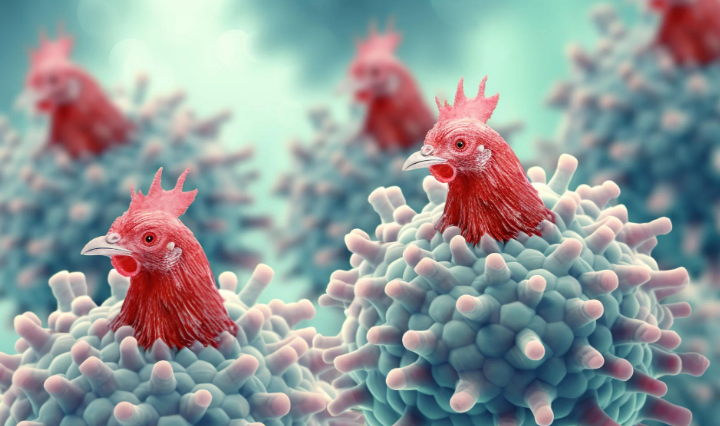Bird Flu Transmission in Cows: Recent Experiment Brings Positive Findings
The world of microbiology and epidemiology recently received a significant boost with a study exploring the transmission of bird flu in cows. This experiment, which aims to delve into the intricacies of cross-species viral transmissions, has yielded some fascinating and promising results.
Understanding Bird Flu and Its Impact
Bird flu, also known as avian influenza, is a highly contagious viral infection that primarily affects birds. However, certain strains have shown the capacity to infect mammals, including humans. The H5N1 strain, in particular, has been a cause of global concern due to its high mortality rate in humans and its potential to cause pandemics.
Symptoms and Transmission in Birds
Bird flu manifests in birds with symptoms such as:
- Sudden death
- Respiratory distress
- Swelling of the head, neck, and eyes
- Drop in egg production
- Diarrhea
The virus spreads among birds through direct contact with contaminated nasal, respiratory, or fecal matter. The possibility of transmission to other species, including cows and humans, is what drives ongoing research.
The Experiment: Exploring Cross-Species Transmission
In a groundbreaking study, scientists investigated the capability of bird flu to transmit to and infect cows. The primary objective was to evaluate whether cows could serve as an intermediary host for the avian virus, potentially aiding its evolution and adaptation to other mammalian hosts, including humans.
Study Design and Methodology
The experiment was meticulously designed, involving the exposure of a controlled group of cows to the H5N1 virus. Key procedures included:
- Administering the virus via different routes (intranasal, oral, and intravenous)
- Monitoring the cows for clinical symptoms and immune response
- Conducting periodic testing to detect viral presence and replication
This rational approach allowed researchers to comprehensively assess the interaction between the virus and the bovine immune system.
Initial Findings and Observations
The initial results of the experiment are exceptionally positive. Key observations include:
Limited Virus Replication: The virus struggled to replicate efficiently in the cows, reflecting their strong innate immunity to the H5N1 strain.
- No Significant Clinical Symptoms:
The cows did not exhibit severe symptoms, and their health remained largely unaffected.
Minimal Viral Shedding: The amount of virus shed by the cows was negligible, reducing the risk of further transmission.
Interpreting the Results: What Do They Mean?
The findings of this study have several important implications for both animal and human health.
Implications for Animal Health
Reassurance for Livestock Farmers: The results offer reassurance to livestock farmers, indicating that cows are unlikely to become significant reservoirs for bird flu. This alleviates concerns about potential outbreaks within cattle herds, ensuring the stability of the livestock industry.
Focus on Biosecurity Measures: Despite the positive findings, it remains imperative for farms to maintain stringent biosecurity measures. Preventing cross-species transmission is crucial, and farms should continue to implement robust protocols to minimize any potential risks.
Implications for Human Health
Reduced Pandemic Risk: The study highlights a lower likelihood of avian influenza adapting to infect cows, thereby decreasing the risk of the virus mutating and potentially becoming more transmissible among humans. By understanding the barriers to cross-species transmission, public health strategies can be better informed, ultimately reducing pandemic threats.
Further Research Opportunities: The positive outcomes of this experiment open new avenues for research. Scientists can delve deeper into understanding the mechanisms that prevent effective viral replication in cows. This knowledge can be leveraged to develop novel antiviral strategies and enhance preparedness for potential outbreaks.
The Future of Avian Influenza Research
The study’s findings represent a significant step forward in avian influenza research. However, the journey does not end here. Continuous research and vigilance are essential to stay ahead of evolving pathogens and emerging threats.
Advancing Knowledge and Preparedness
Investigating Other Mammalian Hosts: While cows have shown resistance to H5N1, it is crucial to explore the potential for transmission to other mammals. Extensive studies on pigs, ferrets, and other animals will provide a comprehensive understanding of cross-species transmission dynamics.
Developing Effective Vaccines: Continued efforts are needed to develop vaccines that can protect both animals and humans from avian influenza. Effective vaccination strategies will be pivotal in controlling outbreaks and safeguarding public health.
Global Collaboration and Surveillance
Strengthening International Cooperation: The fight against avian influenza requires global collaboration. Sharing data, resources, and expertise across borders is essential for effective surveillance and response. Scientists, veterinarians, and public health officials must work together to monitor and control the spread of the virus.
Early Detection Systems: Developing robust early detection systems for avian influenza is critical. Rapid identification of viral outbreaks in both avian and mammalian populations allows for swift intervention measures, reducing the impact of potential pandemics.
Conclusion: Promising Insights and a Path Forward
The recent experiment investigating the transmission of bird flu in cows has yielded encouraging and positive findings. The limited virus replication and lack of significant clinical symptoms provide reassurance to livestock farmers and offer valuable insights for public health strategies. Moving forward, continuous research, international collaboration, and the development of effective vaccines will be crucial in mitigating the risks posed by avian influenza.
The scientific community’s dedication to understanding the complexities of cross-species viral transmission is a testament to our collective commitment to global health and safety. With ongoing vigilance and proactive measures, we can build a healthier and more resilient future for both animals and humans.









